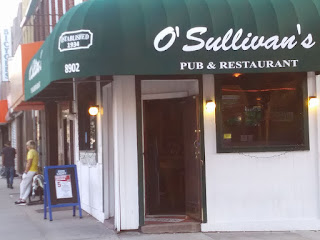Eight Million Stories

I walked down Sixth Avenue in the rain on Friday night and watched the Empire State Building disappear into the mist.
It was an eerie, film noir kind of setting and it fit so perfectly with my evening. I had just gotten done viewing the International Center of Photography’s Weegee exhibit, "Murder is My Business" and I was in a B-movie state of mind.
Weegee, the nom de flash for Arthur Felig, was a famous New York press photographer of the 1930s and ‘40s who captured the soul of the city in all its glorious mayhem.
Gangland slayings, four-alarm fires, car wrecks, raucous celebrations, Weegee recorded it all in screaming black and white.
This was my second go-round with Weegee, having gone to an earlier exhibit at the center back in 1997 when I first moved back to New York. But that’s okay; I can never get enough Weegee.
Legend has it that Weegee, a phonetic rendition of Ouija, got his handle because of his uncanny ability to show up at the scene of the madness—sometimes before the cops did.
Walking through the exhibit, I felt like I was traveling through time, back to the era that I consider New York’s golden age.
I know this golden age business is just a fantasy, a rose-colored flashback of a time I never knew, but I still love that period of the city’s history.
Weegee’s world was often violent, a nighttime battle zone where a bartender could be murdered by a group of young thugs; where a gangster’s corpse could be given a grim send-off by being stuffed into a steamer trunk; and where a bread truck driver could be killed by a runaway car and laid out dead on the street surrounded by the staff of life.
It’s the kind of world where you could be alive and well one minute and dead and bleeding in the gutter in the next. This is a scary town, no doubt, filled with mugs and molls, grifters and goons, and liberally splashed with blood, but when seen through Weegee’s lens, it's the only place you want to be.
Survival of the Fittest
Weegee was great at capturing the faces of the crowd as they streamed out of their tenements to bear witness to the carnage. His Speed Graphic could carve the individual lives out of a mob of gawking faces and plant them deep in your memory.
Weegee lived for action and the exhibit includes a recreation of his Spartan apartment, which had little more than a bed, a police radio, and cameras. He had a portable darkroom in the back of his car so he could bring his photos to life as soon as possible.
The setting reminded me of my police reporting days in Pennsylvania, where I pretty much lived the same type of existence. He seemed obsessed with creating an image of himself, on being the man in the know, the guy on the spot. I know that feeling, too. You witness enough of this grief and you start feeling like the news is your personal property. People become props in your story.

In 1945, Weegee put out his first book of photographs called Naked City. The book was the inspiration for the film “The Naked City,” a fantastic police procedural film that plays across fabulous New York locations and reaches its climax with a shootout on the Brooklyn Bridge.
The movie, in turn, inspired a TV series of the same name, which always ended with the sign off “there are eight million stories in the Naked City; this has been one of them.”
Weegee is gone now and newspapers are cutting back and shutting down. Darkrooms harken back to the dark ages and just about everyone carries a camera in their cell phone.
I wonder about the future of the photograph in this age of instant video. Will there be a time when the single image becomes extinct?
Weegee’s world may be violent, but there’s also a sense of survival in his work, a feeling that no matter how terrible things get, the city and its people will always be here.
I took one last look at the vanishing skyscraper and then headed down the subway station to catch the train to Brooklyn. Yes, there are indeed eight million stories in the Naked City and Weegee captured them in a way that nobody else could.



Comments
OMG....it was so cool to read about Weegee! And for some reason, I somehow remember seeing that book (The Naked City) in a book store at one time.
"I know this golden age business is just a fantasy, a rose-colored flashback of a time I never knew, but I still love that period of the city’s history."
I do too, Rob. I love that period!
"I wonder about the future of the photograph in this age of instant video. Will there be a time when the single image becomes extinct."
Good point! And between digital photography and Photoshop, there no longer seems to be photographs in their RAW form. Everything is touched up and manipulated.
Excellent post, buddy! Thoroughly enjoyed it!
Have a great week!
Sure, there are phone cameras everywhere, but it takes more than a point and shoot in the hands of an amateur to make a great shot.